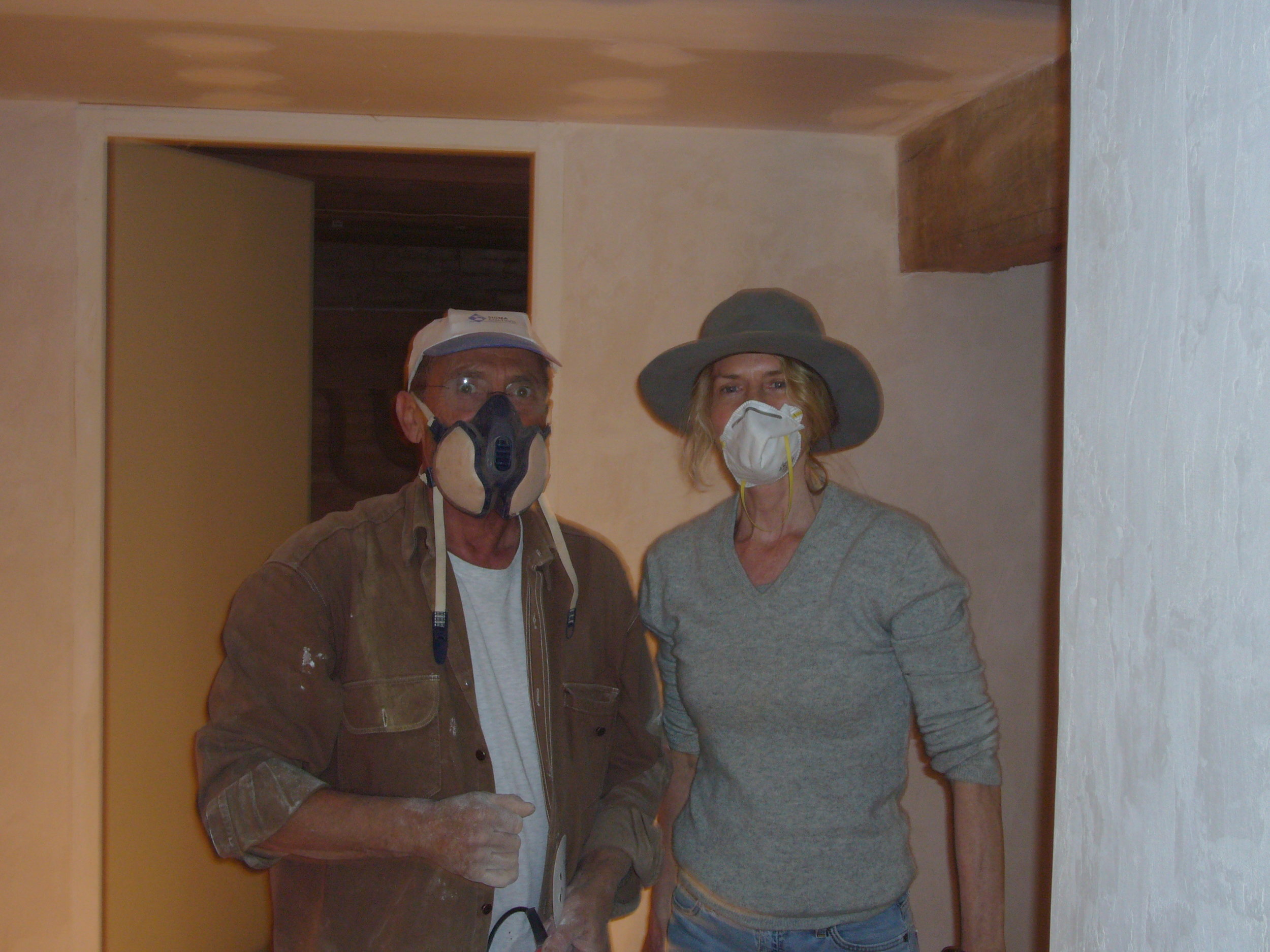Finding French workmen...
who are Italian, Portuguese...
THE OLD GAS TANK AND THE PIGEON HOUSE 2005
It's now the end of March and I'm still having trouble finding people to work on the restoration. Except for Mr. Bruni, of course, who is busy downstairs sanding the 1950’s cement off the floors and swearing profusely, as usual –– putain!, merde! ––for self-motivation. "Well, you know," he tells me, "it’s a bit late in the season to get workmen.” Stupid me. I had no idea there were SEASONS in France for workmen.
Mister BRUNI AND ME SURVIVING THE CEMENT DUST!
But I do manage to get a local plasterer.
Monsieur Gomes is Portuguese, sturdily built, and appropriately white-faced. He also has a low center of gravity, like an opera singer, and walks shoulders back, leading with his stomach. Like everyone else, he is halted by the gaping holes in the ceilings upstairs, now big enough to see the rafters above and, alarmingly, I notice, several slits of daylight. "Madame Lewis," he says—his voice is also operatic, a deep baritone, and he pronounces it Low-eees —"Tout est pourri!
"Yes, I know," I say. "Rotten."
As it's obviously too expensive to build new ceilings he says he'll suspend placoplatre (fiber board) in every room, then plaster over that. “Will it look authentic?” I ask, imagining a sleek insurance brokers office in downtown Los Angeles. Having fallen in love with the ruin, tampering with so much as a rusty doorknob now is like a stab in the heart. Authentique? He looks utterly non-plussed. And I don’t press the point, too grateful that he’s shown up in the first place.
A few days later, I arrive and M Gomes’ men have started. Two of them are on ladders drilling steel runners into the walls. Finished in my bedroom, the fiberboards are already in place. Not only have they covered the tops of the windows, making it impossible to hang a curtain pole, but they have also “leveled” the charming 1810 slant to the ceiling so that the old beams now look crooked—comically deep at one end, shallow at the other. My heart sinks.
“The boards will have to come down,” I tell them. “You will just have to re-attach them flat against the ceiling.” There is an awkward silence. The workmen stare at me from the tops of their ladders like angry circus performers. “Come down? Impossible,” they shout in unison. Im-possible!
“No, not impossible - pas impossible,” I reply firmly. “Im-per-a-tive!” I am practicing my sulky Jean Moreau look. And after a moment, they reluctantly start to unscrew the runners. A minor victory in building aesthetic. Or so I think...
AFTER REATTACHING THE RUNNERS HIGHER-- BUT BEFORE TAKING OUT THE STOVE.
Because two days after that, I find the black marble fireplace in there smashed, on the floor in pieces – and the chimney collapsed.
Apparently, M Gomes’ boys, in removing the old isinglass stove ( not that I'd asked ) have yanked at it too hard. "Un accident!" they say, nonchalantly. Perhaps. Though I suspect this happened after I ordered them to take down the rails. M.Gomes is profusely apologetic–– “desole Madame Low-eees”–– he says. And he actually rebuilds the chimney for me, fitting the old marble pieces together—not exactly in their original order and, admittedly, with one or two crucial bits missing, but I’m grateful nevertheless.
M Bruni, seeing the jig saw-shaped fireplace, laughs, nudging me with one dust-caked elbow: “You see, I told you you’d never find anyone good. It’s too late!”
2010 - An old screen hides the broken bits in the marble fireplace







